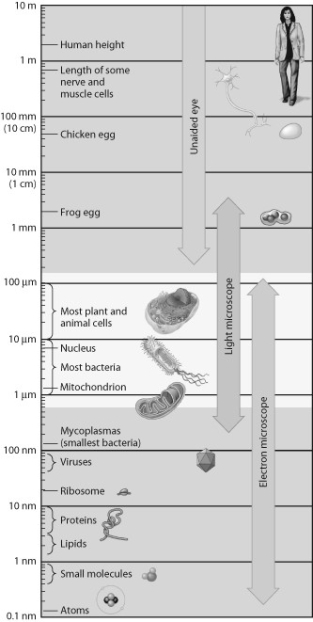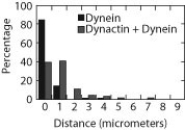A) smooth endoplasmic reticulum; lysosomes
B) rough endoplasmic reticulum; smooth endoplasmic reticulum
C) smooth endoplasmic reticulum; rough endoplasmic reticulum
D) microbodies; lysosomes
F) C) and D)
Correct Answer

verified
Correct Answer
verified
Multiple Choice
According to the accompanying figure, which of the following are large enough to see in the light microscope? 
A) atoms
B) proteins
C) viruses
D) mitochondria
F) A) and C)
Correct Answer

verified
Correct Answer
verified
Multiple Choice
A pathologist who wants to examine a patient's liver cells to determine if the mitochondria have an internal structural defect will likely need to use a
A) light microscope.
B) transmission electron microscope.
C) scanning electron microscope.
D) fluorescence microscope.
F) A) and C)
Correct Answer

verified
Correct Answer
verified
Multiple Choice
Intermediate filaments
A) guide the movements of chromosomes.
B) surround the nucleus.
C) guide the movements of organelles.
D) support the inner mitochondrial membrane.
F) None of the above
Correct Answer

verified
Correct Answer
verified
Multiple Choice
During cell reproduction, chromatin fibers coil up into structures called
A) ribosomes.
B) lysosomes.
C) chromosomes.
D) nucleoli.
F) B) and D)
Correct Answer

verified
Correct Answer
verified
Multiple Choice
An immune system cell called the plasma cell produces thousands of antibodies (a type of protein) per second for release into the body. What type of intracellular structure would you expect to be very prominent within the cell?
A) the smooth endoplasmic reticulum
B) the rough endoplasmic reticulum
C) peroxisome
D) microtubules
F) A) and C)
Correct Answer

verified
Correct Answer
verified
Multiple Choice
The main function of the rough endoplasmic reticulum is the production of
A) mitochondria and proteins secreted by the cell.
B) hydrogen peroxide and steroid hormones secreted by the cell.
C) ribosomes and steroid hormones.
D) membrane and proteins secreted by the cell.
F) A) and B)
Correct Answer

verified
Correct Answer
verified
Multiple Choice
Which of the following statements about cells is true?
A) All cells have cell walls.
B) All cells have internal structures that move.
C) All cells are attached to other cells.
D) All cells are motile.
F) A) and C)
Correct Answer

verified
Correct Answer
verified
Multiple Choice
The accompanying figure shows data from an experiment in which researchers measured how far dynein (a motor protein) traveled in the presence and absence of dynactin (another type of protein) . The y-axis shows the percent of the time that the researchers observed either dynein or dynein + dynactin "walking" a certain distance on a microtubule. What can you conclude from these data? 
A) The addition of dynactin caused dynein to travel farther along the microtubule.
B) Dynein traveled farther in the absence of dynactin.
C) A higher fraction of the dynein proteins were motile in the absence of dynactin.
D) Dynactin would have the same effects on dynein movement on microfilaments.
F) B) and D)
Correct Answer

verified
Correct Answer
verified
Multiple Choice
The oil from the sebaceous glands is produced by which of the following cell organelles?
A) ribosomes
B) the rough endoplasmic reticulum
C) the cell membrane
D) the smooth endoplasmic reticulum
F) C) and D)
Correct Answer

verified
Correct Answer
verified
Multiple Choice
The endomembrane system includes all of the following organelles except the
A) plasma membrane.
B) endoplasmic reticulum.
C) peroxisome.
D) Golgi apparatus.
F) C) and D)
Correct Answer

verified
Correct Answer
verified
Multiple Choice
A scientist wants to magnify a pollen grain 8,000 times and examine the ridges and pores on its surface. Which of the following instruments would be best?
A) a transmission electron microscope
B) a scanning electron microscope
C) a fluorescence microscope
D) a light microscope
F) C) and D)
Correct Answer

verified
Correct Answer
verified
Multiple Choice
Mitochondria differ from chloroplasts in that mitochondria
A) convert light energy from the sun to chemical energy, whereas chloroplasts convert one form of chemical energy to another.
B) contain three different membrane-bound compartments, whereas chloroplasts contain two.
C) contain membrane folds called cristae, whereas chloroplasts contain disklike vesicles in stacks called grana.
D) are not found in plants, whereas chloroplasts are not found in animals.
F) All of the above
Correct Answer

verified
Correct Answer
verified
Multiple Choice
Studies of the endomembrane system often involve the use of a protein that can emit a green fluorescence (glow) . A researcher wants to make a video of cell behavior, so she initially labels the outer nuclear envelope of a cell with the fluorescent tag and records a video for several hours. Later, she sees that the tag is part of a transport vesicle very close to the plasma membrane. -The fluorescent tag likely became incorporated into which of the following organelles during the video?
A) mitochondria
B) ribosomes
C) endoplasmic reticulum
D) peroxisomes
F) B) and C)
Correct Answer

verified
Correct Answer
verified
Multiple Choice
Which of the following cells has the greatest surface-to-volume ratio?
A) bacterium
B) human red blood cell
C) human muscle cell
D) ostrich egg
F) B) and C)
Correct Answer

verified
Correct Answer
verified
Multiple Choice
The function of the nucleolus is
A) to manufacture polypeptides.
B) to manufacture ribosomal RNA.
C) intracellular digestion.
D) to store chromatin.
F) B) and C)
Correct Answer

verified
Correct Answer
verified
Multiple Choice
The skin is the body's largest organ. It's made up of many different types of cells. Oils, produced by the sebaceous glands, prevent the skin from drying and splitting. The pigment melanin, produced by melanocytes in the epidermis, protects the skin from the harmful effects of ultraviolet radiation. Sweat, released through ducts to the skin surface, helps to cool the body. The types of cells that produce these compounds have different numbers of specific organelles, depending on their function. -Melanocytes use many enzymes to produce melanin. Based on their function, you would expect melanocytes in the skin to have a higher than usual number of
A) lysosomes.
B) chloroplasts.
C) ribosomes.
D) microtubules.
F) A) and B)
Correct Answer

verified
Correct Answer
verified
Multiple Choice
The diameter of most animal and plant cells ranges from
A) 0.1 to 1.0 micrometers.
B) 1.0 to 10 micrometers.
C) 10 to 100 micrometers.
D) 100 to 1,000 micrometers.
F) A) and B)
Correct Answer

verified
Correct Answer
verified
Multiple Choice
Which of the following statements about plant cell walls is false?
A) Plant cell walls consist of cellulose fibers embedded in a matrix of polysaccharides and proteins.
B) Plant cell walls are multilayered structures.
C) Plant cell walls protect plant cells by forming an impermeable layer around the cell.
D) Wood is primarily composed of plant cell walls.
F) B) and C)
Correct Answer

verified
Correct Answer
verified
Multiple Choice
A manufacturing company dumps its wastes into a nearby pond. One of the wastes is found to paralyze the contractile vacuoles of certain protists. A biologist looking at individual samples of these organisms taken from the pond would find that they
A) have lost water and shrunk.
B) have gained water and burst.
C) have died of malnutrition.
D) have died because wastes have built up in the cytoplasm.
F) None of the above
Correct Answer

verified
Correct Answer
verified
Showing 21 - 40 of 93
Related Exams